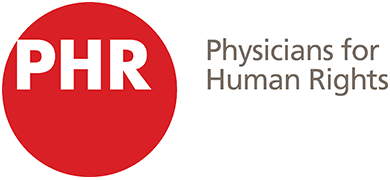A woman with her daughter visiting a Marie Stopes Kenya outreach site, where she can receive family planning and VCT services. (Amanda Cary/PHR)
For the past month, we've been posting stories and lessons learned from Kenya regarding the integration of family planning and HIV/AIDS services as a critical strategy to halt the feminization of AIDS. This weekly blog series—kicked off in honor of International Women's Day on March 8—draws from a December 2008 Physicians for Human Rights trip to Kenya, where I joined Lisena DeSantis, Health Action AIDS Kenya Program Associate, to learn about integrated services directly from the providers, clients, local NGO staff and government officials with firsthand knowledge.
Throughout our many conversations, we heard the message loud and clear: integration of family planning and HIV/AIDS services provides critical linkages to HIV/AIDS prevention, care and treatment (PDF) and in this way serves as a vital intervention in stopping the feminization of the AIDS epidemic.
Furthermore integrating these services is a powerful strategy to decrease physical and social barriers to the health system and provide more services in more places for more people. In other words, it is a strategy that actualizes a right to health framework by promoting the availability, accessibility, acceptability and quality of health services.
It is obvious. Mothers who come to the health facility for family planning want to take advantage of the [voluntary counseling and testing for HIV] because they overcame barriers to get here. If I come here, I get family planning and voluntary counseling and testing. That is a package. That is access. (Dr. Muguche, Manager of Outreach for Marie Stopes Kenya)
Indeed, it is obvious. We, as advocates for the right to health, must reinvigorate strategies and policies for implementing integrated family planning and HIV/AIDS services on a global scale. While advocacy around PEPFAR reauthorization had many successes last year, the reauthorized bill still does not give the necessary attention to family planning services in the fight against AIDS.
One of our challenges now is to ensure that the PEPFAR 2 implementation strategy makes the integration of HIV and family planning services standard practice in PEPFAR-supported HIV service delivery. In the coming year, PHR will be meeting with policymakers and PEPFAR officials to demonstrate the importance of creating one stop shops to fight the AIDS epidemic and promote the right to health.
As our work continues, I will remember Emma, the nurse and fellow health professional advocate who offers a one stop shop with family planning and HIV/AIDS voluntary testing and counseling (VCT) services for her clients in Kenya. Emma began providing her one stop shop after witnessing the struggle her clients faced to access health services and recognizing the right of each of her clients to be cared for holistically within the health system. Emma shows us that providing comprehensive services for women is by no means impossible. Yes, there are major gaps and major needs; but health workers, such as Emma, are changing the paradigm and demanding more from the system they work in, looking for the simplest, most cost-effective way to provide the needed services. Indeed, they are blazing a trail for the rest of us to follow.

